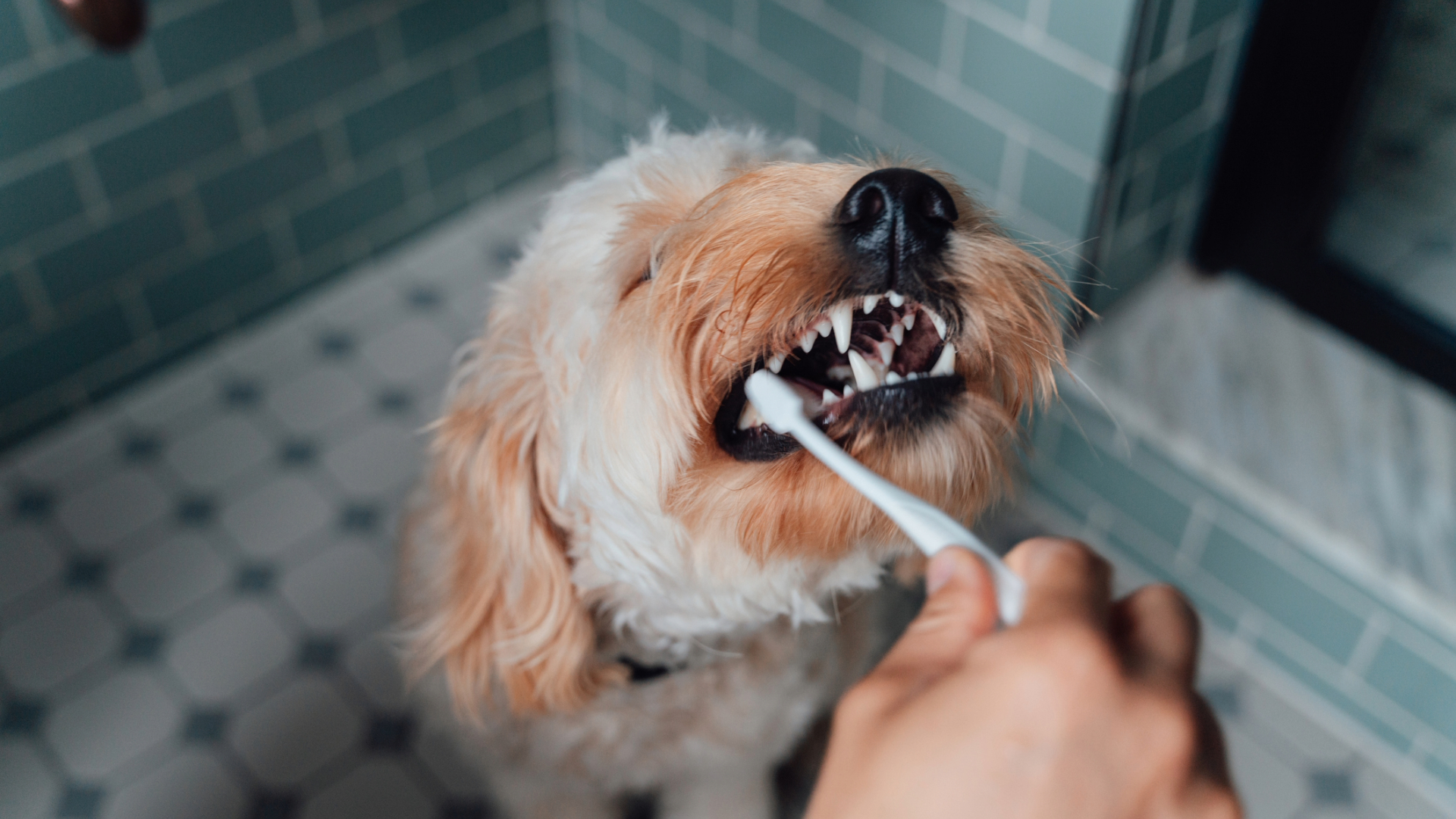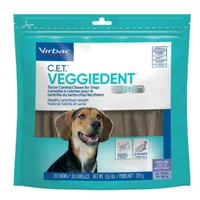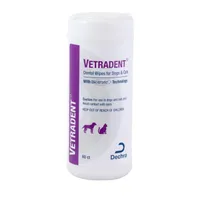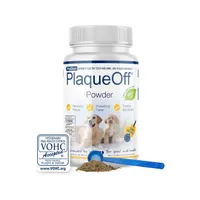How to remove tartar build-up in dogs, according to a vet
An expert explains the best way to remove tartar build-up in dogs.

Tartar build-up in dogs is a common dental issue owners and vets frequently encounter. If it's not properly addressed, this condition can lead to serious dental problems.
Tartar, also known as calculus, forms in your dog's mouth when plaque—a soft, sticky substance—builds up on the teeth. If plaque is not removed, it hardens over time due to minerals in the dog’s saliva, forming tartar. Left untreated, tartar buildup can cause bad breath, gum disease, and even tooth loss.
The good news is that tartar buildup is preventable and treatable. With the right products and practices, you can keep your dog’s mouth clean and healthy. Start by getting the best toothbrush for dogs, the best dog toothpaste, and learning how to brush a dog’s teeth.
Below, Emma Chandley, a small animal vet surgeon with more than 13 years of experience, will guide you through effective methods to remove tartar from your dog’s teeth.
Why does my dog have so much tartar?
Tartar build-up in dogs is caused by a combination of a few different things accumulating in their mouth. These include:
- Bacteria in the mouth help to form plaque, a sticky film that clings to teeth.
- Food particles can get stuck in between the teeth and contribute to plaque build-up.
- Saliva contains minerals that can harden the plaque, turning it into tartar.

The formation of tartar starts when plaque accumulates on your dog’s teeth. Plaque is a sticky film that forms when bacteria mix with saliva and food debris. This film can build up quickly, especially if your dog eats wet food or a carbohydrate-rich diet.
If plaque is not removed by brushing (or other methods), it hardens within 24 to 48 hours, becoming mineralized tartar. Once tartar has formed, it’s much harder to remove and often requires professional cleaning by a vet.
Get the best advice, tips and top tech for your beloved Pets
Factors that influence tartar build-up in dogs:
Diet
Dogs that eat soft or moist food are more prone to tartar buildup. This type of food tends to stick to their teeth, promoting plaque formation. Hard, dry kibble may help scrub the teeth through mechanical debridement and reduce plaque accumulation, but this alone should not be relied upon.
Lack of dental care
Without regular brushing or professional cleaning by a vet, tartar accumulates easily. Dogs that don’t receive routine dental care are more likely to develop tartar.
Genetics and breed
Some dog breeds are more susceptible to tartar buildup. Smaller breeds, for example, often experience dental issues because their teeth are closer together, or their mouths are overcrowded, making it easier for plaque to accumulate.
Age
Older dogs are more likely to have prolonged exposure to plaque, increasing the likelihood of tartar development. As dogs grow older, their teeth are subjected to more wear and tear as well, which can facilitate the development of tartar.
Health conditions
Certain health conditions, such as kidney disease, diabetes, and hormonal imbalances, can contribute to poor dental health, making tartar buildup more likely. Some medications may also dry out a dog’s mouth, exacerbating the problem.
How can I remove tartar from my dog's teeth?
Tartar buildup should never be ignored, as it can lead to dog gum disease and tooth loss. Regular cleaning and use of appropriate products can help maintain your dog's dental hygiene. Here are several methods for removing tartar from your dog’s teeth:
Brushing your dog’s teeth
Brushing your dog’s teeth is the most effective way to prevent and reduce tartar build-up. Regular brushing removes plaque before it hardens into tartar. Use a toothbrush designed specifically for dogs and make sure to choose dog-safe toothpaste. Regular brushing is the most effective way to maintain your dog's dental health. You might be tempted to make homemade dog toothpaste, but it's always best to stick to a store-bought option that's formulated for your pooch.
Dental chews and treats
The best dental chews for dogs can be useful for mechanically scrubbing teeth and helping to reduce plaque and tartar. Many dental chews also contain ingredients like enzymes or antibacterial agents, promoting better oral health.
Virbac C.E.T. VeggieDent Fr3sh Dental Chews
A popular choice for lots of vets is these plant-based chews, which come in various sizes for all dog breeds. They help to reduce plaque and tartar, plus improve bad breath.
Dental wipes
Dental wipes are another convenient option for improving your dog’s oral hygiene. These wipes remove plaque and bacteria from the teeth and gums, especially for dogs that are hesitant about using a toothbrush. Wrap the wipe around your finger and gently rub it across your dog’s teeth and gums.
VETRADENT Organic Natural Mild Vanilla Flavored Dog & Cat Dental Wipes
These dental wipes are highly recommended, helping to remove plaque and prevent bacteria. They're free from xylitol, alcohol, and chlorhexidine.
Water and food additives
Water and food additives help reduce plaque and tartar formation by killing bacteria in your dog’s mouth. These additives usually contain enzymatic ingredients or chlorhexidine, which help reduce bacterial growth and plaque accumulation. Plus, they promote fresher breath, which is a nice added benefit!
ProDen PlaqueOff Powder Dog & Cat Supplement
Lots of vets recommend using PlaqueOff. This powder supplement can be sprinkled onto your dog's food and helps plaque, tartar and bad breath.
Dietary adjustments
Switching from wet to the best dry dog food can improve oral health. Crunching dry food helps scrape away plaque from the teeth. Additionally, dental diets are formulated to reduce plaque and tartar formation as your dog chews. Many dental foods also contain enzymes that help break down plaque and tartar over time.
Professional dental cleaning
In some cases, professional dental cleaning may be necessary. Your vet can perform a thorough scale and polish under general anesthesia, using ultrasonic equipment to remove all tartar, including areas that are difficult to reach with a toothbrush. If there are any rotten teeth that need extraction, this can be done at the same time.

What’s the difference between plaque and tartar?
Understanding the difference between plaque and tartar is essential for maintaining your dog’s oral health.
- Plaque is a soft, sticky film that forms on the teeth when bacteria mix with food particles and saliva. Plaque is easier to remove through regular brushing or dental treats. However, if left untreated, plaque hardens and becomes tartar.
- Tartar (or calculus) is hardened plaque that has become mineralized over time. It forms a yellow or brown layer on the teeth and is much harder to remove. Tartar usually requires professional cleaning by a vet. Tartar can extend below the gumline, creating pockets that trap bacteria and lead to gum disease, tooth decay, and even damage to the jaw bones.
Why they're both bad for dogs:
- Plaque may be softer, but it still irritates the gums and causes bad breath. When plaque isn’t removed, it leads to gum inflammation and more severe dental issues, causing pain for your dog.
- Tartar buildup causes gingivitis, periodontal disease, and tooth decay, and can even result in tooth loss. The bacteria in tartar can enter the bloodstream and cause infections in other organs, making it a serious health risk. Tartar buildup also causes pain and discomfort, especially when it leads to inflamed gums and loose teeth. We also have a helpful feature on dog teeth rotting.
We also have helpful advice on how to keep dog teeth clean and healthy and have answered, 'Can you use regular toothpaste on dogs?'
Emma Chandley is a vet with 14 years of experience and has a keen interest in surgery. After graduating from the Royal Vet College in London in 2011, she achieved a postgraduate certificate in small animal surgery from the British Small Animal Veterinary Association and Nottingham Trent University. She was then awarded advanced practitioner status in the same discipline by The Royal College of Veterinary Surgeons. She has a black Labrador and two pygmy goats at home.




